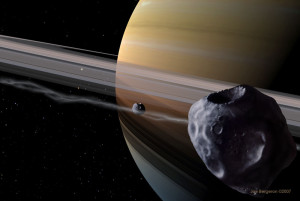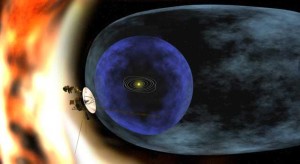How Do Saturn’s Moons Affect The Rings
Saturn’s rings might have disappeared a long time ago without these celestial bodies…
Without them Saturn would be just another gas giant, but the Saturnian system’s rings have been a thing of wonder since Galileo first spotted a pair of fuzzy ‘ears’ around our solar system’s second largest planet some 400 years ago.Since we’ve only recently started to explore the outer planets, there is still some debate as to the actual origin of Saturn’s rings.
While some think they originate from a moon that could have succumbed the Roche limit (when a body reaches an orbit close enough to its parent body to be literally ripped apart by gravitational forces) or obliterated by a comet, others think the ring system is almost as old as Saturn itself and is in fact material left over from the planet’s own creation.
One thing scientists are quite sure about is the vital role a selection of Saturn’s 62 moons play in the ring system’s outstanding beauty. These Shepherd moons actually shape and maintain the crisp edges separating the famous rings on their orbits between the various ‘gaps’ – without them the Saturnian system’s crowning jewel might not even exist at all.
 While a single Shepherd moon’s gravity is capable of pushing and pulling the small particles of a particular ring into a uniformed knife edge, the outer F-Ring is an example of a ring maintained by a pair of Shepherds – Prometheus and Pandora – one either side of the ring. Working together they hold the material in place like a pair of inter-planetary bookends.
While a single Shepherd moon’s gravity is capable of pushing and pulling the small particles of a particular ring into a uniformed knife edge, the outer F-Ring is an example of a ring maintained by a pair of Shepherds – Prometheus and Pandora – one either side of the ring. Working together they hold the material in place like a pair of inter-planetary bookends.
There’s still a lot to learn about Saturn’s Shepherd moons, not least because more are being discovered. The most recent Shepherd spotted keeping tabs on the outer B-Ring was found just last year as part of the Cassini mission, but with a diameter of little more than 300 metres it’s barely perceptible, even to man’s most advanced orbiting probes.
![Voyager missions]() Up close and personal
Up close and personal
Before we ventured into ‘deep’ space with the Voyager missions launched in the late Seventies it was thought that Saturn only had a small selection of rings. It wasn’t until Voyager 1 and 2 sent back nearly 2,000 pictures of the Saturnian system that the rings were revealed and tens of thousands of lesser rings were seen. (source: https://voyager.jpl.nasa.gov/)
These missions and the more recent Cassini mission confirmed that these intricate structures were the handiwork of a partnership between Saturn’s larger moons and smaller Shepherd moons.

